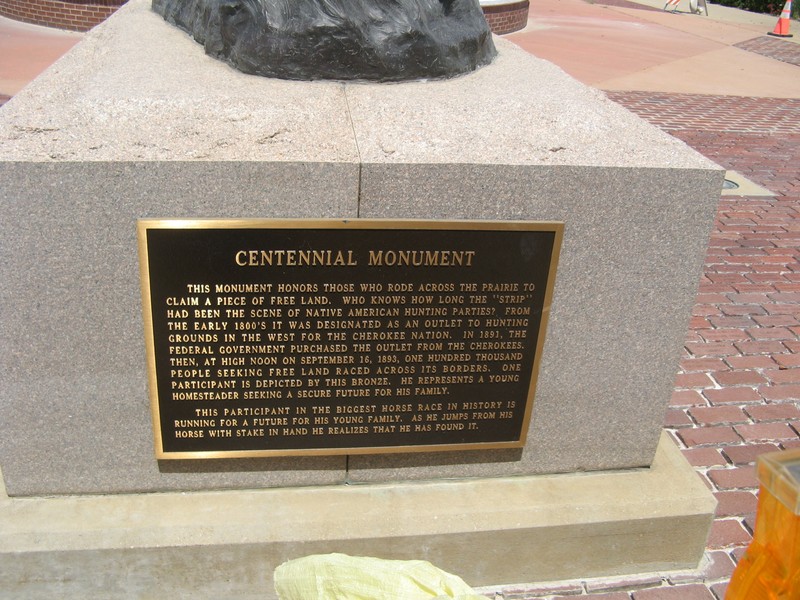Centennial Statue
Introduction
Text-to-speech Audio
Monument commemorating the centennial of the 1893 Cherokee Strip Land Run. The original title of the work, "This Land is Mine," was stripped from the work in response to protest from the local Native American community, who objected to the title's suggestion that white settlers were justified in taking Native lands.
Images
This Land is Mine

Centennial Monument plaque

Backstory and Context
Text-to-speech Audio
Residents of Ponca City--home of the famous Pioneer Woman statue and accompanying Pioneer Woman Museum--commissioned a heroic-sized monument to mark the centennial of the Cherokee Outlet land opening. Like other land rush monuments erected in the late 20th century, it depicts a highly masculine scene that counterbalances the Pioneer Woman's focus on women carrying cultural refinement to the frontier. Local artist Jo Saylor’s ten-foot-tall bronze statue of a white cowboy preparing to jump off his rearing horse to stake his claim depicted the masculine excitement of the land rush even more dramatically than Harold T. Holden's popular Boomer that had been installed in Enid, Oklahoma, a few years earlier.
Ponca City’s Native American population vocally protested the erection of a statue commemorating white men staking claims to Indian lands. In Ponca City protests focused on the artist’s title for the work, This Land is Mine, which blatantly ignored prior indigenous and emigrant Indian claims to local lands. Around the same time, activists also protested David Manuel's statue titled The Promised Land that was donated to Portland, Oregon, to mark the sesquicentennial of the Oregon Trail.1
In protesting Ponca City's This Land is Mine, Native communities chose to overlook the complex history of intertribal tensions in the former Indian Territory and to embrace a pan-Indian tactic to fighting white incursion into Native lands. The Ponca, who had been forcibly removed to the region in the mid-nineteenth-century (and who lent their name to the predominately white town) led public opposition to the Cherokee Outlet land run monument. Ponca tribal member Ed Little Cook was not satisfied by the deletion of the offensive title. Instead, he argued for removal of the statue because it celebrated the theft of Indian lands. The official tribal statement about the statue, penned by Ponca administrative assistant Sherman Bo Warrior, labeled the land runs a form of genocide. Members of the emigrant Cherokee and Ottawa soon joined the fight; tribes that lived in the area prior to forced relocations, including the Osage, who had the strongest historical claim to the area, as well as the Tonakawas, Kaws, Pawnees, and Otoe-Missourias, were far less vocal in protesting the land rush monument.2
Vocal protest from the local Indian community persuaded the city to remove the offensive title, and to place the statue in a slightly less prominent location. More than 300 Native protestors sang, chanted and beat a ceremonial drum nearby as the monument was dedicated without an official title before a crowd of 3,500 in September 1993. Ponca City’s centennial committee chair declared flippantly in response to the protestors, “This is one of the greatest honors. I’ve never had background music.”3
Racial tensions surrounding the centennial commemoration persisted long after the statue’s dedication. Frustrated with the many Ponca City residents who remained determined to celebrate their white pioneer forebears, the American Indian community chose to erect their own monument and memorial park in which to tell their perspective on local history. Two years after Ponca Isaiah Williams erected a white artist’s composite, peaceful Indian figure in Enid (discussed above), Poncas in Ponca City unveiled Southern Ute/Navajo Cowboy Artist of America Oreland C. Joe’s twenty-two-foot tall statue of Ponca Chief Standing Bear.4 Standing Bear fought for the Ponca people--and by extension all Native Americans--through the United States legal system. In a landmark 1879 civil rights case in U.S. District Court, Standing Bear argued successfully that Native Americans are defined as persons in relation to federal law and entitled to citizenship rights. Oreland Joe’s statue became the centerpiece of sixty-three-acre Standing Bear Park, Museum and Education Center, which seeks to educate visitors on the culture and history of Native Americans in Oklahoma. It also serves as a memorial to a former residential neighborhood that was razed after a Conoco oil leak contaminated its groundwater on that site.5
Text of a plaque at the monument's base:
CENTENNIAL MONUMENT
THIS MONUMENT HONORS THOSE WHO RODE ACROSS THE PRAIRIE TO CLAIM A PIECE OF FREE LAND. WHO KNOWS HOW LONG THE "STRIP" HAD BEEN THE SCENE OF NATIVE AMERICAN HUNTING PARTIES? FROM THE EARLY 1800'S IT WAS DESIGNATED AS AN OUTLET TO HUNTING GROUNDS IN THE WEST FOR THE CHEROKEE NATION. IN 1893, THE FEDERAL GOVERNMENT PURCHASED THE OUTLET FROM THE CHEROKEES. THEN, AT HIGH NOON ON SEPTEMBER 16, 1893, ONE HUNDRED THOUSAND PEOPLE SEEKING FREE LAND RACED ACROSS ITS BORDERS. ONE PARTICIPANT IS DEPICTED BY THIS BRONZE. HE REPRESENTS A YOUNG HOMETEADER SEEKING A SECURE FUTURE FOR HIS FAMILY.
THIS PARTICIPANT IN THE BIGGEST HORSE RACE IN HISTORY IS RUNNING FOR A FUTURE FOR HIS YOUNG FAMILY. AS HE JUMPS FROM HIS HORSE WITH STAKE IN HAND HE REALIZES THAT HE HAS FOUND IT.
Sources
- Prescott, Cynthia Culver. Pioneer Mother Monuments: Constructing Cultural Memory. Norman, Oklahoma. University of Oklahoma Press, 2019.
- Swain, Joseph Benjamin Norris. "Claims to History: Commemorating Progress in Oklahoma Territory, 1989-2007." University of Oklahoma, 2008.
- McNutt, Michael. Ponca City Remembers Settlers | Indians Protest Statue Dedication, NewsOK.com. Accessed June 16th, 2017. http://newsok.com/ponca-city-remembers-settlers-indians-protest-statue-dedication/article/2442217.
- McNutt, Michael. Standing Bear Statue Leading Tribe's Influence in Ponca City, NewsOK.com. Accessed June 16th, 2017. http://newsok.com/article/2543064.
- Swain, "Claims to History."
Photo by David Prescott
Photo by David Prescott
